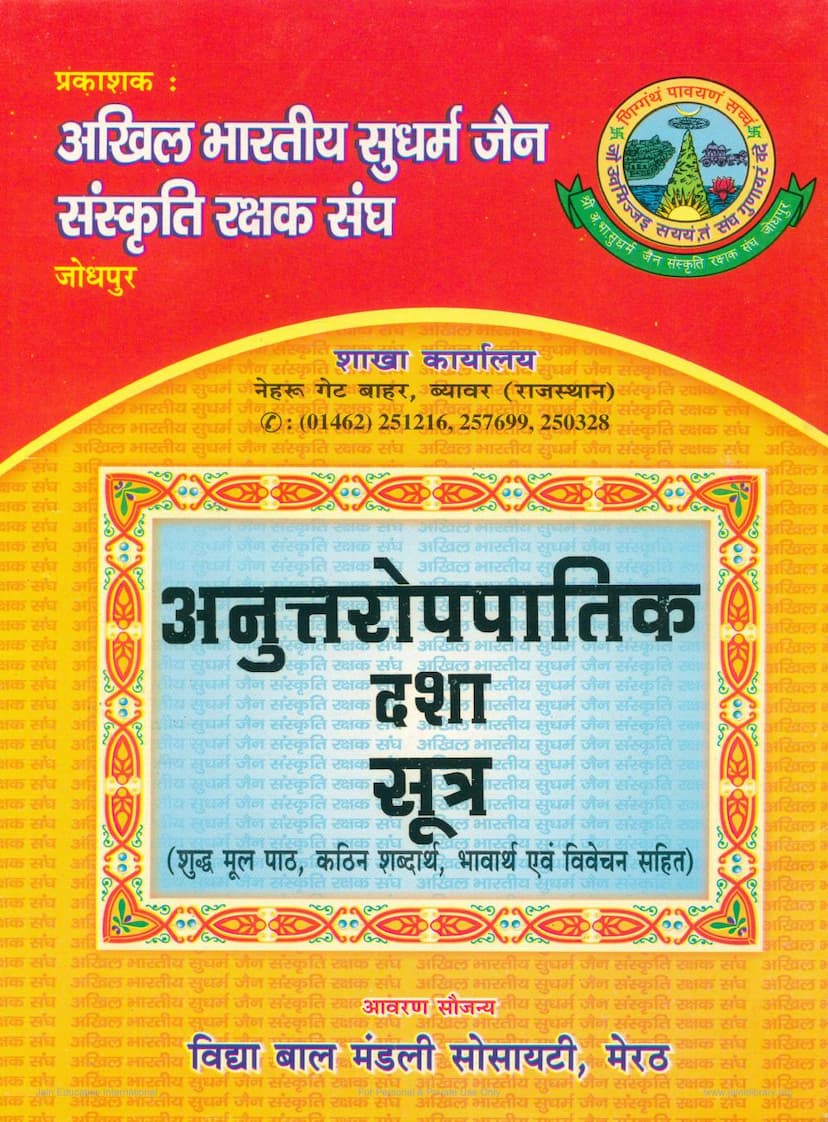Anuttaropapatikdasha Sutra
Added to library: September 1, 2025

Summary
The "Anuttaropapātikadaśā Sūtra" is a sacred Jain text, specifically the ninth Anga of the Agamas, which are the scriptures of Jainism. The title itself translates to "The Chapter on Those Born in the Highest Realms," indicating its primary focus.
Here's a comprehensive summary based on the provided text:
Core Subject Matter:
The Sutra primarily describes the lives and spiritual journeys of individuals who, through their rigorous asceticism and virtuous conduct in this life, have attained rebirth in the Anuttara Vaimānas (unexcelled celestial abodes). It details how these beings will eventually complete their lifespan in these celestial realms and then descend to the Mahāvideha Kṣetra (a holy land in the Jain cosmology) to attain Mokṣa (liberation).
Structure:
The Sutra is divided into three sections (vargas):
- First Section (Prathama Varga): This section contains ten chapters (adhyayanas). These chapters primarily focus on the lives of twenty-three sons of King Śreṇika, who renounced worldly life and attained rebirth in the Anuttara Vaimānas. A notable figure detailed in this section is Abhayakumāra, known for his sharp intellect and advisory role. The first chapter specifically details the life of Jālikumāra. The text also mentions Meghakumāra and the rigorous Guṇaratnasaṃvatsara tapa (a specific penance).
- Second Section (Dvitīya Varga): This section contains thirteen chapters. It describes the spiritual accomplishments of thirteen princes, who are also identified as sons of King Śreṇika and Queen Dhāriṇī, and in some cases, Queen Celanā and Queen Nandā. Their rigorous penances led them to rebirth in various Anuttara Vaimānas. The first chapter of this section focuses on Dīrghasena Kumāra.
- Third Section (Tṛtīya Varga): This section contains ten chapters. It highlights the lives of ten significant spiritual aspirants. The most detailed and emphasized life in this section is that of Dhanakumāra (Dhanṇa Anagāra), a wealthy merchant's son who became an ascetic. His extreme penance, including adhering to strict āyambila (a type of fasting) and consuming minimal, rejected food, is elaborately described. The other nine individuals mentioned are Sunakṣatra, Ṛṣidatta, Pellaka, Rāmaputra, Candrika, Ṛṣimātu, Peḍhalaputra, and Poṭṭilla. The life of Dhanakumāra is presented as a prime example of extreme asceticism and spiritual dedication, even earning praise from Lord Mahāvīra himself.
Key Themes and Teachings:
- The Fruit of Asceticism: The central theme is the immense spiritual merit gained through severe penance, self-control, and renunciation. This merit leads to rebirth in the highest celestial realms.
- The Importance of Knowledge and Conduct: The Sutra emphasizes the study of the eleven Angas (canonical scriptures) and adherence to the principles of Jain conduct (such as samiti and gupti) for spiritual progress.
- Detachment from Worldly Pleasures: The lives of the princes and ascetics, even those from royal families or wealthy backgrounds, demonstrate the ultimate renunciation of material comforts and sensual pleasures for the sake of spiritual liberation.
- The Role of Devotion and Guru-Disciple Relationship: The interactions between the ascetics and Lord Mahāvīra (and later, Ārya Sudharma Swami and Ārya Jambu Swami) highlight the importance of devotion and seeking guidance from a spiritual master.
- The Path to Mokṣa: The Sutra illustrates that rebirth in the Anuttara Vaimānas is a significant step, but the ultimate goal is the attainment of Mokṣa in the Mahāvideha Kṣetra, which is achieved through continued spiritual practice.
- Exemplary Lives: The detailed accounts of individuals like Dhanakumāra serve as role models, inspiring followers to undertake rigorous spiritual practices.
- The Power of Intellect: Abhayakumāra's story, in particular, showcases how sharp intellect, when applied to ethical and spiritual matters, can be a powerful asset.
Narrative Style:
The text employs a question-and-answer format, primarily between Ārya Jambu Swami and his teacher Ārya Sudharma Swami. This serves to elucidate the teachings of Lord Mahāvīra. The descriptions of the ascetics' emaciated bodies due to severe penance are vivid and detailed, using numerous similes to convey their extreme physical condition while simultaneously highlighting their inner spiritual radiance.
Significance:
The "Anuttaropapātikadaśā Sūtra" is considered an important text for understanding the Jain concept of karma, rebirth, and the path to liberation, particularly for those who achieve exceptionally high spiritual states. It provides detailed accounts of the practices that lead to such elevated rebirths and the eventual attainment of Mokṣa. The detailed descriptions of ascetic practices and their results offer profound lessons on the power of discipline and detachment.